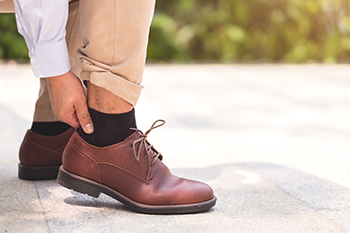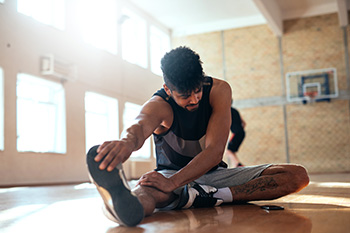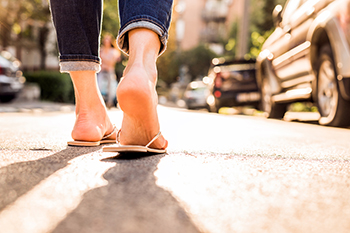Items filtered by date: May 2023
Avoiding Pain When Standing All Day for Work

Blisters, shin splints, and swollen feet are just a few of the foot problems that can result from standing all day at work. There are various ways to lessen pressure on the feet during and after working hours. Some of these include making sure to wear shoes that are supportive, fit correctly and have a closed toe. It is beneficial to use anti-fatigue mats, in addition to practicing exercises to strengthen the feet and legs for a demanding work schedule. Relief may also be found when the feet are soaked in warm water and massaged after the workday. There are many other ways to prepare and take care of your feet when standing is mandatory. It is suggested that you visit a chiropodist to find out more information about how to maintain proper foot care while working.
If you stand all day, you may be at an increased risk of developing various foot conditions. If you are experiencing foot pain of any kind, please consult with Chiropodist Stephanie Poupore from North Bay Foot & Ankle. Our clinician will assess your condition and provide you with quality foot and ankle treatment.
What Foot Problems Are Caused by Standing?
Standing all day at work may increase your risk of developing foot or ankle problems.
Some common foot conditions that may arise from spending all day on your feet include:
Foot pain
Blisters
Corns and calluses
Arthritis
Flat feet
Bunions
Sprains
Athlete’s foot
Prevention
If you stand for prolonged periods of time for work, taking preventative measures to preserve the health of your feet is strongly recommended.
Measures you can implement to help prevent foot problems include:
Wearing shoes that are comfortable and fit well - these shoes should be made of breathable materials and provide you with arch support and cushioning. It is best to avoid shoes that have heels or narrow toe boxes.
Taking breaks to rest, walk, and stretch your feet throughout the day
Maintaining good foot hygiene - wash and dry your feet thoroughly every day
If you have any questions, please feel free to contact our office located in . We offer the newest diagnostic and treatment technologies for all your foot care needs.
Feet and Toe Stretches

The toes are an important part of the foot to regularly exercise, and there are specific stretches that can improve range of motion and flexibility. A toe lift can be performed by sitting with the feet flat on the floor, while lifting the toes to the same height. This can be repeated after holding for several seconds. The big toe can become more flexible when practicing a big toe pull. This is accomplished by wrapping a towel around the big toe while sitting with the feet on the floor. As the towel is pulled toward the body while pushing against it with the foot, the toe can become stronger. It can feel good to point and flex the feet, which can be beneficial in strengthening the heel and calf muscles. Many people enjoy practicing doming, which is done by gripping the floor with the toes while sitting down. This can also be repeated after holding the stretch for several seconds. If you would like more information about the benefits of stretching the feet and toes, it is suggested that you confer with a chiropodist who can help you with correct stretching techniques.
Stretching the feet can improve their flexibility and overall strength, and can help prevent or reduce the impact of foot injuries. For more information about stretching your feet, please consult with Chiropodist Stephanie Poupore from North Bay Foot & Ankle. Our clinician will assess your condition and provide you with quality foot and ankle treatment.
Why Stretching the Feet Is Important
Your feet support the weight of your entire body as you go about your daily activities. As with any other part of your body, stretching and exercising the feet can help maintain their overall health, reduce foot pain, and prevent future injuries.
How to Stretch
There are a variety of foot stretches and exercises that you may try. It is recommended that you speak with a chiropodist to learn which exercises are best for you.
Some examples include:
Heel Raises - Hold onto a wall for balance as you slowly rise up on your tiptoes. Hold the position for several seconds, then lower your feet back to the ground. Repeat 10 times.
Toe Splay - Sit in a chair with your feet flat on the ground. Spread your toes as far apart as you can, holding for several seconds. Repeat 10 times.
Towel Scrunches - Sit in a chair and lay a towel flat on the floor in front of you, placing your foot on top of it. Using only your toes, scrunch up the towel pulling it towards you. Repeat several times with each foot.
Plantar Fascia Massage - Sit in a chair and place a round or cylindrical object (such as a tennis ball, water bottle, or foam roller) under the arch of your foot. Slowly push your foot forward and backward while applying pressure to the object. Maintain the object between your heel and toes. Do this for about 30 seconds. Repeat on the other foot.
If you have any questions, please feel free to contact our office located in . We offer the newest diagnostic and treatment technologies for all your foot care needs.
Arthritis Can Cause Pain in the Feet and Ankles
Why You Should Be Careful With Flip-Flops

As summer approaches, many people start thinking about going to the beach and enjoying the warm weather. When our bodies are warmer, we start to shed the extra layers of clothing we have been wearing in the cold weather, and pull out the shorts and sandals. Flip-flops are shoes many people own and include in their summer wardrobe. While they are easy to wear, and can be an inexpensive way to coordinate an outfit, it is important to keep in mind that frequently wearing flip-flops may not be good for the feet. Flip-flops require a gripping action of the foot to keep them on, which may lead to taking shorter strides. The alteration in gait from wearing flip-flops affects everything above the feet, including the hips, knees, and back. This can easily lead to excessive pronation, which can further stress the body, create pain, and can cause other foot problems. If you enjoy wearing flip-flops, it is suggested that you keep their use minimal, and contact a chiropodist to discuss better alternative summer footwear.
Flip-flops, though they may seem harmless, are bad for your foot health. If you would like to learn more about the many problems that can be caused by frequent flip-flop wear, please consult with Chiropodist Stephanie Poupore from North Bay Foot & Ankle. Our clinician can help you maintain the health of your lower limbs and your mobility.
Flip-flops are the quintessential summer shoe, seemingly perfect for the beach or pool. Unfortunately, these flimsy shoes are not a good choice when it comes to keeping your feet healthy.
Frequently wearing flip-flops is associated with:
Hammertoes
Bunions
Plantar fasciitis
Heel spurs
Cracked heels
Plantar warts
Athlete’s foot
Foot pain
Foot and ankle injuries
Gait changes
Leg, hip, and back pain
The best way to avoid these issues is to swap your flip-flops for more protective and supportive shoes. If you must wear flip-flops, wear them only for short periods of time.
If you have any questions, please feel free to contact our office located in . We offer the newest diagnostic and treatment technologies for all your foot care needs.
Toenail Fungus

Toenail fungus, or onychomycosis, is caused by a fungus that can penetrate the nail through small cracks in the nail or surrounding skin. The toenails can become thickened, brittle, and discolored, and sometimes the nail can separate from the nail bed. Those more prone to toenail fungus include the elderly, people who are diabetic, or who have endured a toe injury. This condition is generally not serious, despite being unsightly, and it can be uncomfortable while wearing shoes. A culture or stain can be taken to confirm that a fungus is present and not due to another cause. Treatment for toenail fungus can be topical or systemic. The toenails grow slowly and often take time to heal. In severe cases, the toenail may be removed. To help prevent toenail fungus, it is helpful to keep the feet clean and dry, cut toenails straight across, and refrain from sharing nail clippers. If you suspect that you have toenail fungus, it is suggested that you see a chiropodist to confirm the diagnosis and get appropriate treatment.
Toenail fungus can be uncomfortable and unsightly. If you have diabetes or a compromised immune system, it may also be dangerous. To learn more about treatment options, please consult with Chiropodist Stephanie Poupore from North Bay Foot & Ankle. Our clinician will assess your condition and provide you with quality foot and ankle treatment.
What Does Toenail Fungus Look Like?
A fungal infection of the toenail may cause the affected nail to become thickened, brittle, crumbly, and yellowish or brown in color. Sometimes the toenail may separate from the nail bed, become deformed, emit a foul odor, or cause pain or discomfort.
What Causes Toenail Fungus?
Toenail fungus is caused by a fungus that infects the nail bed. The fungus lives and thrives in warm and moist environments and is also contagious. Athlete’s foot, which is a fungal infection of the skin, may spread to the nails and cause toenail fungus.
What Treatments Are Available?
Potential treatments for toenail fungus may include oral antifungal medications, topical antifungal medications, such as medicated nail polishes that are applied directly to the affected nail, and laser therapy. Sometimes, a combination of treatments is prescribed.
If you have any questions, please feel free to contact our office located in . We offer the newest diagnostic and treatment technologies for all your foot care needs.
Symptoms and Causes of Athlete’s Foot

Athlete's foot is a common infection that generally affects the space between the toes or the soles of the feet. It is caused by a fungus called dermatophytes. Athlete’s foot symptoms include red and cracked skin that can become flaky and itchy. The affected skin also can turn white and become slightly swollen. In rare cases infection may cause redness, blisters, and pus-filled bumps or open sores. When the infection spreads along the sole of the foot, it is called moccasin foot. Dermatophytes can enter the body through tiny cracks or sores in the skin. Athlete’s foot is highly contagious and can easily be spread by stepping on a flake of skin from an infected foot. These fungi thrive in moist, warm environments, including the inside of your shoes, as well as public showers and locker rooms. They also feed on keratin, a protein that can be found in the top layer of skin. While athlete’s foot is not considered a serious health problem, it can spread to other parts of the feet or hands, if ignored. It also does not go away on its own. Therefore, it is suggested that you make an appointment with a chiropodist who can discuss efficient treatment options.
Athlete’s foot can be uncomfortable and unsightly. To learn more about preventing and treating this condition, please consult with Chiropodist Stephanie Poupore from North Bay Foot & Ankle. Our clinician will assess your condition and provide you with quality foot and ankle treatment.
What Is Athlete’s Foot?
Athlete’s foot refers to an infection of the skin on the feet that is caused by a fungus. This fungus is contagious and thrives in warm and moist environments. It is often spread in common areas such as public pools, locker rooms, and showers. It can also spread when sharing personal items, like shoes or towels, with an infected person.
Symptoms
The symptoms of athlete’s foot may include:
Itching, stinging, or burning of the skin on the feet
Cracking or peeling skin, especially between the toes and on the soles of the feet
Scaly, red rash on the foot
Blisters
Foul odor
Treatment
Treatment for athlete’s foot typically involves using over-the-counter topical antifungal medications on the feet. When over-the-counter options are ineffective, you may need to take prescription oral medications or topical antifungal drugs, or a combination of both.
Prevention
Preventing athlete’s foot places an emphasis on good foot hygiene practices.
You can prevent athlete’s foot by:
Washing and drying your feet thoroughly every day
Wearing shoes when walking in public areas
Not sharing personal items, like shoes or socks, with others
Wearing shoes and socks made out of breathable materials
If you have any questions, please feel free to contact our office located in . We offer the newest diagnostic and treatment technologies for all your foot care needs.

